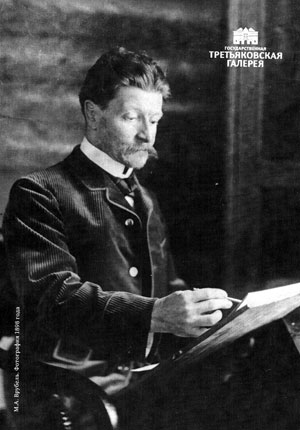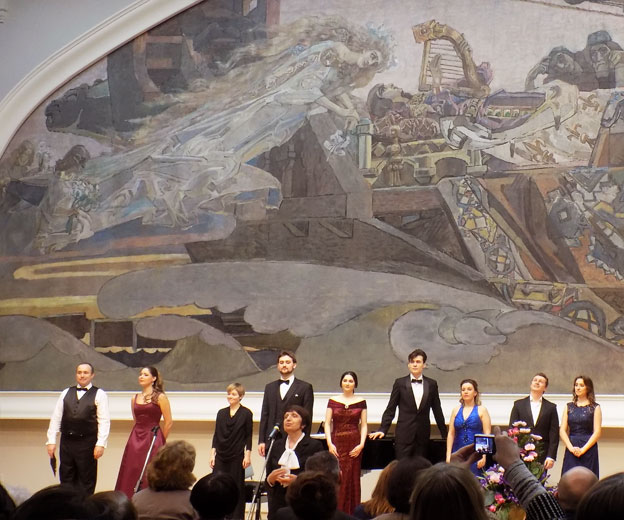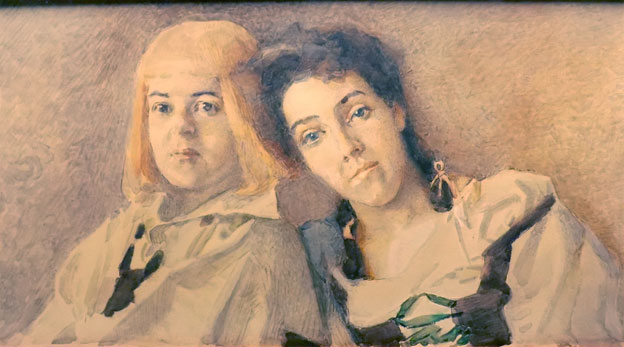On 12 December 2016 in the Vrubel hall in the Tretyakov gallery (TG), Moscow, was opened the exhibition “N. Zabela-Vrubel in the works of M. A. Vrubel”. Thus, the best collection of Russian art opened its vaults and shows visitors on the 160th anniversary since the birth of the artist the story of his love that combines happiness and tragedy, music and painting.
Mikhail Alexandrovich Vrubel (1856-1910) – Russian painter, draughtsman of Polish origin (the name comes from wróbel — Sparrow), a Catholic by religion. A graduate of the class of P. Chistyakov at the St. Petersburg Academy of arts. Basic works are “the Demon”, “the fortune Teller”, “the Swan Princess”, etc. On the artistic style he was close to symbolism, with art Nouveau features. Vrubel died from a mental disorder, during the last 4 years he was blind.
Nadezhda Zabiela became the wife of Mikhail Vrubel when she was 30 and he was 40 y.o. A graduate of the Kiev Institute for noble maidens and the St. Petersburg Conservatory, she was an actress in “blue blood” and a relative of the artist Nikolai GE.

Their acquaintance took place when Vrubel at the request of his patron Savva Mamontov joined the decorating at Panaev theater in St. Petersburg (part of Private Opera). He worked on the Opera by the German composer Humperdinck’s “Hansel and Gretel”, a children’s fantasy based on the fairy tale by the brothers Grimm. Engelbert Humperdink was a follower of the composer-innovator Wagner.
Nadezhda sang Greta and her “unearthly” singing appeared to him not only beautiful, but also close. “Everybody sing like bird, wrote Vrubel – but Nadya sings like a human.” So he met a person, without which he could not do until the end of his life. As later told N. Zabela-Vrubel, he ran on stage during a break and began to express his delight. Picturesque testimony to this experience is a couples portrait of Nadezhda Zabela (Greta) and her partner Tatiana Lyubatovich (Gretel), performed at the request of the bride. This portrait was a prerequisite for the acceptance of an offer of marriage, and is stored in the Tretyakov gallery.
As told the curator of the exhibition Shumanova Irina, senior researcher in the Department of graphics of the XVIII – early XX century, state Tretyakov gallery, the image of his wife affected in different guises and images of Vrubel. She became his Muse, the Seraphim, the prophet…
“Portrait Of N. I. Zabela-Vrubel in the toilet Empire” is also the pearl of the collection of the Tretyakov gallery. Dress of transparent silk, in which she appeared in the portrait, was made by her husband. Thus, the portrait reminds us of the fact that Vrubel wore his beloved wife, preparing himself her outfits and creating her stage images.
The sad thing is “Portrait of son” – Savva Vrubel, the only child of the couple Vrubel, sickly boy, who lived only for 2 years. It is also kept in the Tretyakov gallery.
In addition to these portraits, Tretyakov gallery invites visitors to touch the sculpture to the works of Vrubel and more intimate things associated with his life. For example, to sketches and clothing sketches of Vrubel’s portraits of his wife, his self-portraits, handwritten sheet of memories about them and many other things, extremely dear to the heart of many fans of the Russian artist.

At the opening of the exhibition, with the assistance of the Foundation “Grani”, the Museum staged a dip in the sound that once captivated Mikhail Vrubel. Performed by singers of the Youth Opera program of the Bolshoi theatre, the concert included arias, duets and excerpts of operas by N. And. Rimsky-Korsakov: Sadko, the snow maiden and the Tsar’s bride. The composer highly valued the talent of the singer, saw him as a combination of earthly and unearthly. He will also devote Zabela Vrubel and two romances: “a Midsummer night’s Dream” and “Nymph”.
According to a music critic M. Siegelman, “her age as a singer was short. N. Zabela-Vrubel was star in a small theater, in a chamber performance.” Longer preserved her image, so richly and skillfully depicted in painting husband.
Sources:
Encyclopedia of Russian painting.- M., “OLMA-Press”, 1999.
- Kogan. Mikhail Vrubel. – M., Terra – Book club, 1999.





